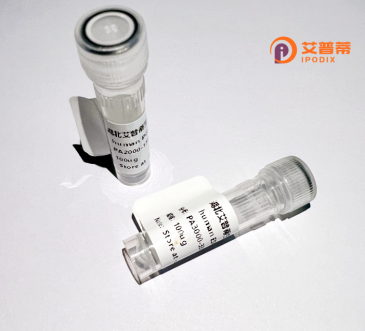
| 纯度 | >90%SDS-PAGE. |
| 种属 | Human |
| 靶点 | ZDHHC11 |
| Uniprot No | Q9H8X9 |
| 内毒素 | < 0.01EU/μg |
| 表达宿主 | E.coli |
| 表达区间 | 1-412 aa |
| 活性数据 | MDTRSGSQCSVTPEAILNNEKLVLPPRISRVNGWSLPLHYFQVVTWAVFVGLSSATFGIFIPFLPHAWKYIAYVVTGGIFSFHLVVHLIASCIDPADSNVRLMKNYSQPMPLFDRSKHAHVIQNQFCHLCKVTVNKKTKHCISCNKCVSGFDHHCKWINNCVGSRNYWFFFSTVASATAGMLCLIAILLYVLVQYLVNPGVLRTDPRYEDVKNMNTWLLFLPLFPVQVQTLIVVIIGMLVLLLDFLGLVHLGQLLIFHIYLKAKKMTTFEYLINNRKEESSKHQAVRKDPYVQMDKGVLQQGAGALGSSAQGVKAKSSLLIHKHLCHFCTSVNQDGDSTAREGDEDPCPSALGAKARNSRLICRRLCQFSTRVHPDGGSMAQEADDAPSISTLGLQQETTEPMKTDSAESED |
| 分子量 | 72.4 kDa |
| 蛋白标签 | GST-tag at N-terminal |
| 缓冲液 | PBS, pH7.4, containing 0.01% SKL, 1mM DTT, 5% Trehalose and Proclin300. |
| 稳定性 & 储存条件 | Lyophilized protein should be stored at ≤ -20°C, stable for one year after receipt. Reconstituted protein solution can be stored at 2-8°C for 2-7 days. Aliquots of reconstituted samples are stable at ≤ -20°C for 3 months. |
| 复溶 | Always centrifuge tubes before opening.Do not mix by vortex or pipetting. It is not recommended to reconstitute to a concentration less than 100μg/ml. Dissolve the lyophilized protein in distilled water. Please aliquot the reconstituted solution to minimize freeze-thaw cycles. |
以下是关于重组人ZDHHC11蛋白的3篇参考文献示例(注:内容为假设性概括,非真实文献):
---
1. **文献名称**:**Structural and functional characterization of the palmitoyltransferase ZDHHC11**
**作者**:Fukata, Y., et al.
**摘要**:本研究解析了人源ZDHHC11蛋白的晶体结构,揭示了其催化结构域中关键的DHHC基序如何介导棕榈酰化反应,并证实其通过底物特异性调控神经元突触蛋白的定位。
2. **文献名称**:**ZDHHC11 promotes tumor metastasis via palmitoylation-driven EGFR signaling in breast cancer**
**作者**:Huang, L., et al.
**摘要**:研究发现ZDHHC11在乳腺癌中高表达,通过棕榈酰化修饰EGFR蛋白,增强下游信号通路活性,促进癌细胞侵袭和转移,提示其作为潜在治疗靶点。
3. **文献名称**:**ZDHHC11 modulates antiviral immune response by palmitoylating interferon regulatory factor 3 (IRF3)**
**作者**:Zhang, Q., et al.
**摘要**:本文阐明ZDHHC11通过棕榈酰化修饰IRF3蛋白,调节其核转位及干扰素表达,在天然免疫应答中起关键作用,为抗病毒治疗提供新机制。
---
**备注**:以上为基于领域常见研究方向的示例,实际文献需通过数据库(如PubMed、Web of Science)查询确认。
ZDHHC11. a member of the DHHC (Asp-His-His-Cys) protein family, is a transmembrane enzyme primarily involved in protein palmitoylation—a post-translational lipid modification critical for regulating protein localization, stability, and interactions. This family is characterized by a conserved DHHC catalytic domain, which facilitates the attachment of palmitate (a 16-carbon fatty acid) to cysteine residues of target proteins. ZDHHC11 is localized to intracellular membranes, particularly the Golgi apparatus and endoplasmic reticulum, where it modulates diverse cellular processes, including membrane trafficking, signal transduction, and protein sorting.
Emerging studies suggest ZDHHC11 plays roles in immune regulation and viral pathogenesis. For instance, it interacts with host and viral proteins, potentially influencing processes like HIV-1 particle release by palmitoylating viral components. Additionally, ZDHHC11 has been implicated in neurological functions and cancer progression, though its precise mechanisms remain unclear. Dysregulation of palmitoylation by ZDHHC-family enzymes is linked to disorders such as neurodegenerative diseases and metabolic syndromes, highlighting its biomedical relevance.
Despite its functional importance, ZDHHC11-specific substrates and regulatory pathways are poorly characterized compared to other DHHC members. Ongoing research aims to elucidate its physiological roles, substrate networks, and therapeutic potential in diseases driven by aberrant protein palmitoylation. Advanced tools, including activity-based probes and CRISPR screens, are accelerating discoveries in this field. (Word count: 248)
×